The best time to visit Tanzania and Kenya is generally from mid-June to October. As East Africa’s dry season, this time of year has the most predictable weather and provides ideal safari conditions.
As two of the world’s most highly-rated safari destinations, a trip to Tanzania or Kenya offers the experience of a lifetime all year round. The ‘best time’ of year to visit East Africa depends on what you hope to experience most during your trip.
In this article:
- Best Weather and Ideal Safari Conditions
- Best Rates and Off-Season Perks: Short rains, Long rains, Shoulder Season
- Best Time for Wildlife Viewing: The Great Wildebeest Migration, Calving Season and River Crossings
- Hippopotamus Spectacle
- Chimpanzee Tracking
- Ngorongoro Crater – Wildlife Wonderland All Year Round
- Masai Mara and Kenya’s Safari Secret
- Birdwatching
- Best Time for the Beach
- Best Time to Climb Kilimanjaro or Mount Kenya
- Where to Visit – Kenya or Tanzania?
Best Weather and Ideal Safari Conditions – Dry Season (June-October)
As the rain subsides and mighty rivers transform into shallow pools, Kenya and Tanzania’s national parks truly come to life. Thick vegetation thins out and animals congregate around scattered sources of water, giving safari-goers the prime conditions to spot wildlife.
While early mornings and evenings might be cold, the temperature during this season is fairly predictable. Thermometer readings are often around 23°C/73°F, reaching a high of 28°C/82°F in the coastal areas.
Many visitors prefer the moderate dry season over the hot, humid and rainy summer months. Another benefit to consider during the dry season of winter is fewer mosquitos and a smaller chance of catching malaria.
There is, however, the risk of an occasional cold front in July when temperatures can reach close to freezing. The five-month window also draws the biggest crowds, which is the biggest disadvantage of the peak season.
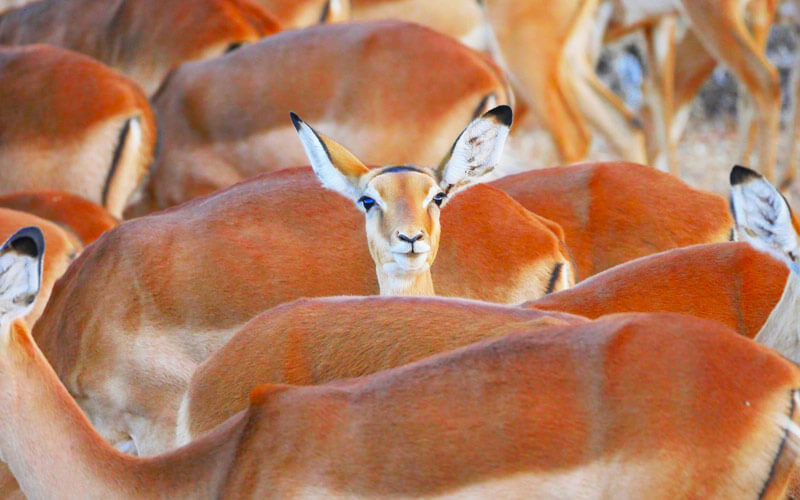
Best Rates and Off-Season Perks – Wet Season (November-May)
The dry landscapes of Tanzania and Kenya are transformed into a lush, green wonderland in the wet season. Temperatures increase during this period and usually range between 24°C/75°F and 27°C/81°F, reaching highs of 30°C/86°F along the coast.
There are three types of rainy periods in this season: Short rains during November and December, Long rains in March and April a Shoulder season in January and February.
Short rains (November-December)
Afternoon thunderstorms are often expected to take place, but safaris are unlikely to be impacted. For this reason, the short rainy season is still considered an excellent time to plan a trip to Tanzania or Kenya.
The first two weeks of December are considered a highly underrated time to visit. With many travellers flying to East Africa for the festive season, the lower demand over early December can result in good deals and special off-peak rates.
The landscape will be spectacularly lush after the November rains and safaris can be planned around the usual afternoon showers.
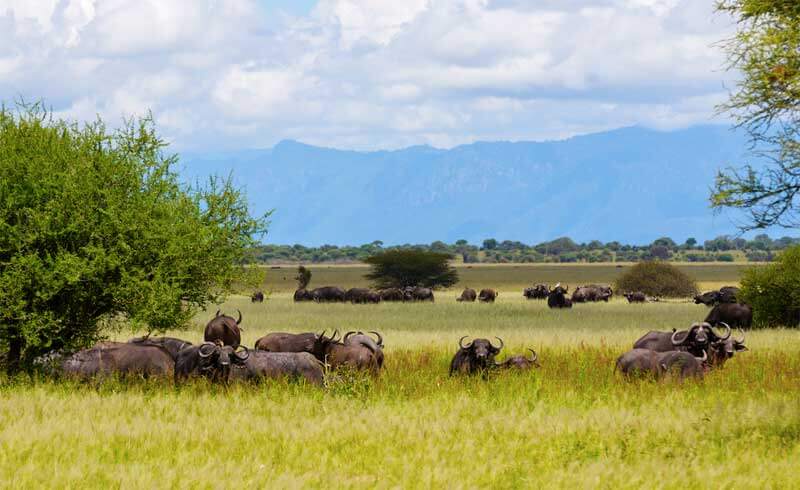
Long rains (March-April)
The long rains usher in the peak of the wet season. While it may still be a good time to visit Tanzania or Kenya, your trip will be impacted by the amount of rain and the type of conditions the area receives that year. Tourists who find hot, humid conditions unpleasant should preferably avoid this season.
If you’re up for an adventure, there are major advantages of travelling here during this time. Prices are reduced dramatically and with crowds being dispersed – you’ll have thrilling wildlife sightings all to yourself.
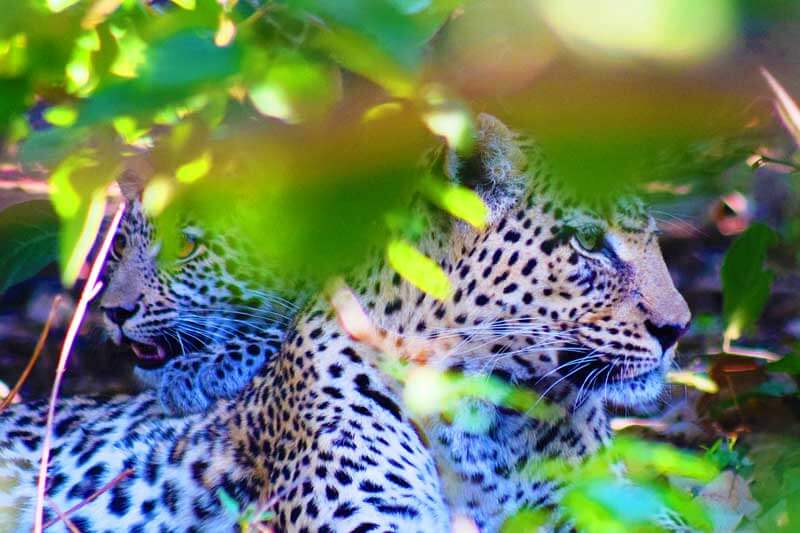
Shoulder Season – Between the Rainy Seasons (January-February)
The start of the year is often a time that is overlooked by many people planning a trip to East Africa. A dry spell usually takes place during this time between the end of the short rains and the start of the long rains.
The green savannah and fewer visitors make this an excellent time to avoid the crowds. Generally considered to be the ‘shoulder season’, festive season rates have dropped and Wildebeest calving season is about to begin in the Serengeti. Many seasoned safari-goers rates the shoulder season as the best time to plan a trip to Tanzania or Kenya.
Best Time for Wildlife Viewing
Both Kenya and Tanzania are home to an abundance of national parks – many of which offer world-renowned wildlife encounters. The wildlife spectacle that you’d like to see most will greatly affect the optimal time of year to visit Eastern Africa.
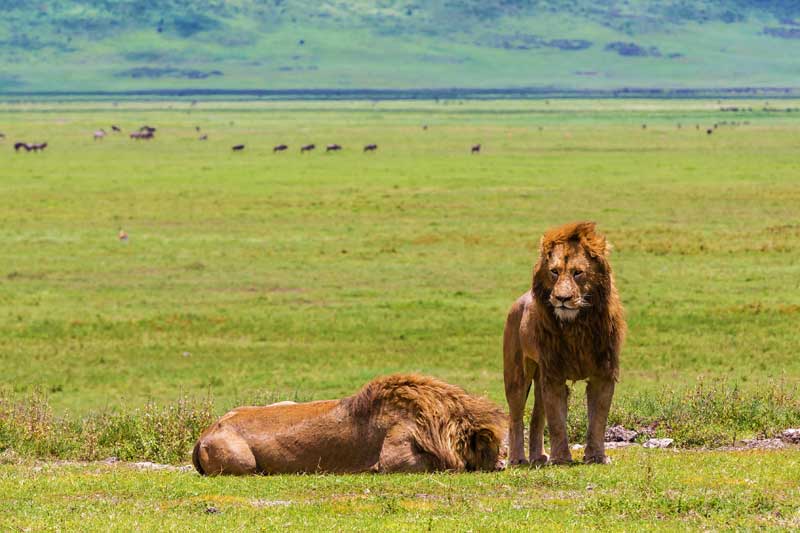
The Great Migration
For most travellers, the best time to visit the Serengeti in Tanzania or Masai Mara in Kenya revolves heavily around the movement of the Great Wildebeest Migration.
Understanding the pattern of the Wildebeest Migration will help you choose the best time of year to visit the Serengeti. In general, the migration tends to be in the Southern Serengeti for the calving season from February to mid-March.
The best months to see the migration are from June-September as animals concentrate around watering holes and rivers.
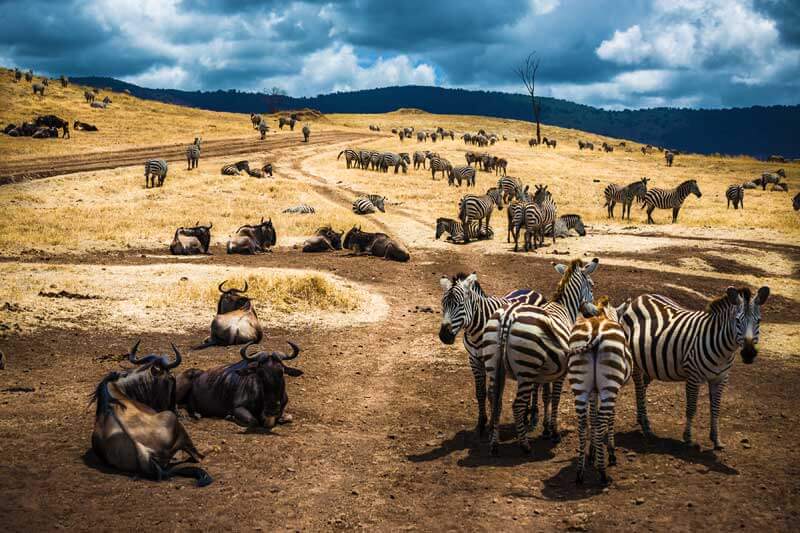
Calving Season – Late January-February
As the migration slows down, this period not only offers a chance to witness the wildebeest drop their young but also brings with it an unprecedented opportunity for predator sightings. With the lurking big cats looking to strike when the herds are most vulnerable.
Generally, April-May is regarded as the low season when conditions are least favourable for wildlife viewing.
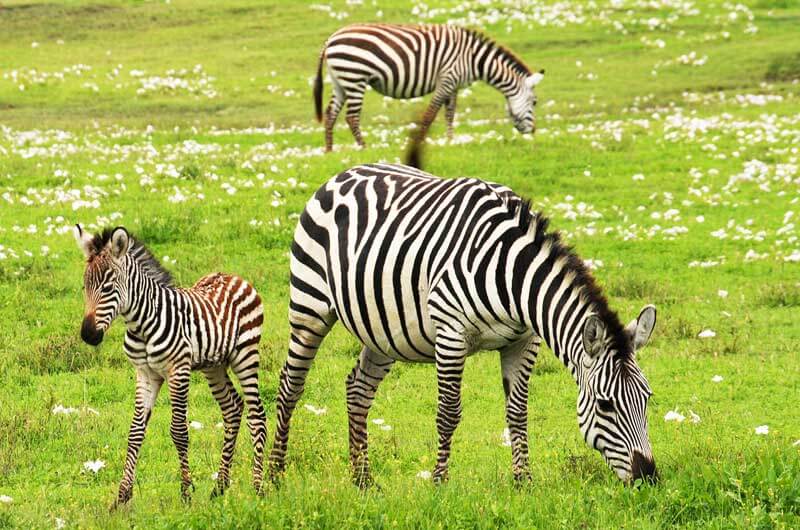
River Crossing – June-August and September
From June-July, it’s easier to spot the herds in the park’s Western Corridor, as they gather near the Grumeti River. From August-September, the grazers move into the Northern Serengeti and Kenya’s Masai Mara National Reserve.
During this season you have the chance of witnessing the famous river crossings across the crocodile-infested Grumeti River from June-July. As well as the crossing of the Mara River from August-September as they enter Kenya. The sweeping herds then head back down to the Southern Serengeti, and the cycle starts again.
See our ultimate guide to the best time to visit the Serengeti.
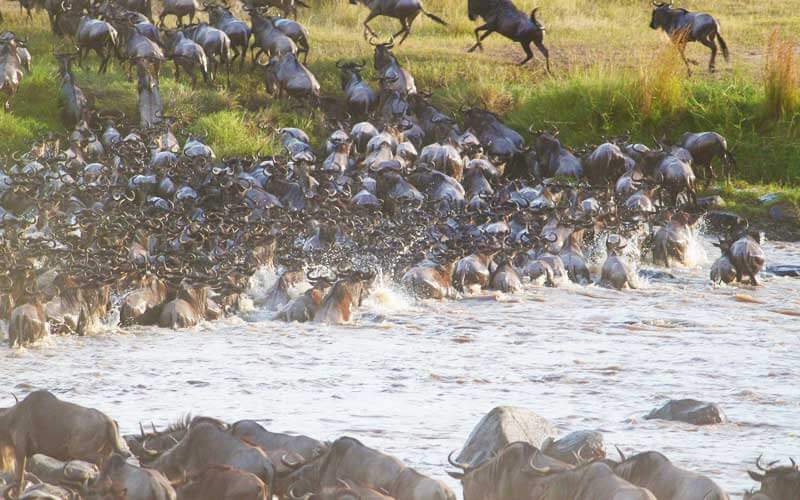
Dry Season Hippopotamus Spectacle
If it’s a spectacular hippo sighting you’re after, Tanzania’s Katavi National Park won’t leave you disappointed. As water levels dwindle with the dry season months (June-October) and floodplains retreat, the Katavi National Park truly comes to life.
The marshy floodplains of the park are home to Tanzania’s densest concentration of crocodiles and hippos. As these floodplains retreat during the dry season, the sight of hippos by their hundreds cramming into dwindling pools is truly a spectacle to witness.
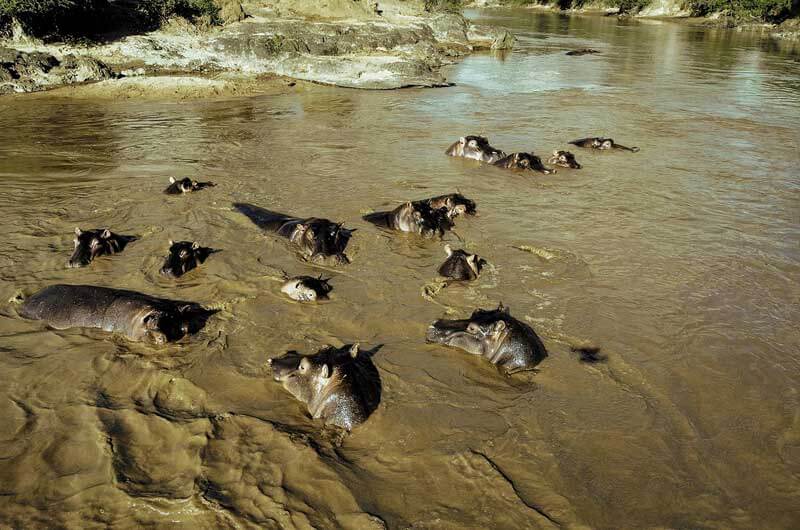
Dry Season Chimpanzee Tracking
A major drawcard to Tanzania is its chimpanzees. This species can only be found in Africa, with most chimps living along the equatorial belt in the rainforest areas. One of these being the majestic Mahale Mountains National Park.
The best time to visit the Mahale Mountains is during the dry season, from June-October. Expeditions to see the chimps are most fruitful during this time, especially towards the back end of the dry season (August-October). The chimps are normally closer to shore and forest paths, which makes looking for them easier to negotiate.
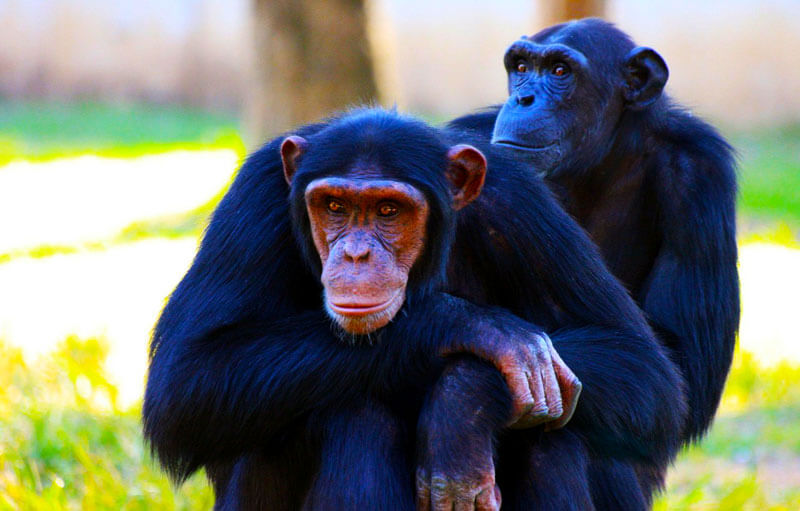
Ngorongoro Crater – Wildlife Wonderland All Year Round
With its status as the world’s largest inactive volcanic caldera, the Ngorongoro Crater is a must-see for most travellers planning a trip to Tanzania.
Fortunately, the enclosed nature of the Crater makes wildlife viewings spectacular all year round. The general ‘high season’ of the Ngorongoro Crater takes place for most of the year from July right up until March. While the dry season is generally regarded as the best time to visit the Ngorongoro Crater, a safari here at any time of year will not leave you disappointed.
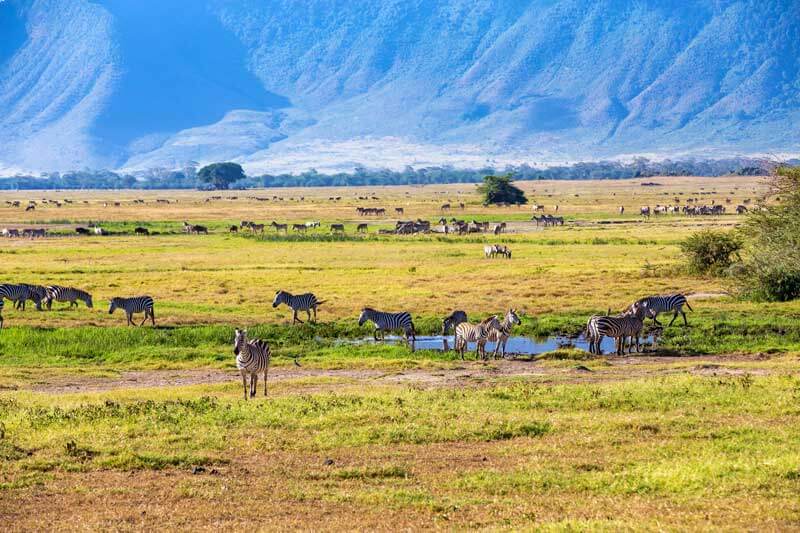
Masai Mara and Kenya’s Safari Secret
Safaris in the Masai Mara are enhanced from August to October as millions of wildebeest leave the Serengeti and cross the famous Mara River into Kenya. The herds remain in Kenya until October when they head southwards again.
One of Kenya’s best-kept safari secrets, however, is a lesser-known local migration. The spectacle unfolds between January-March as herds of wildebeest arrive in Mara from the Loita hills.
With an abundant population of wildlife, a trip to any of Kenya’s parks (most notably the Masai Mara, Amboseli, Nairobi and Lake Nakuru National Park) will seldom leave you disappointed all year round.
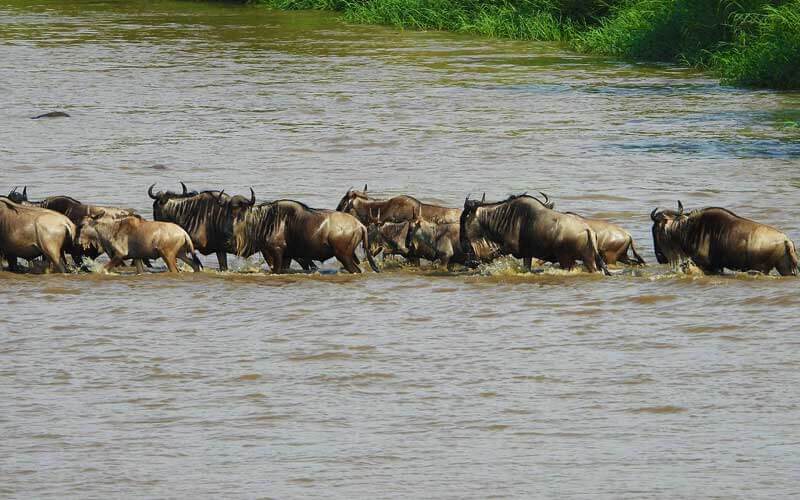
Birdwatching
The varied landscapes across Kenya and Tanzania attract a wide range of bird species. While bird watching is considered to be good all year round, the ideal season is from November-April. During this time European and North African migratory bird species make East Africa their seasonal home.
This is good news for bird enthusiasts who during this time of year get to enjoy off-season rates.
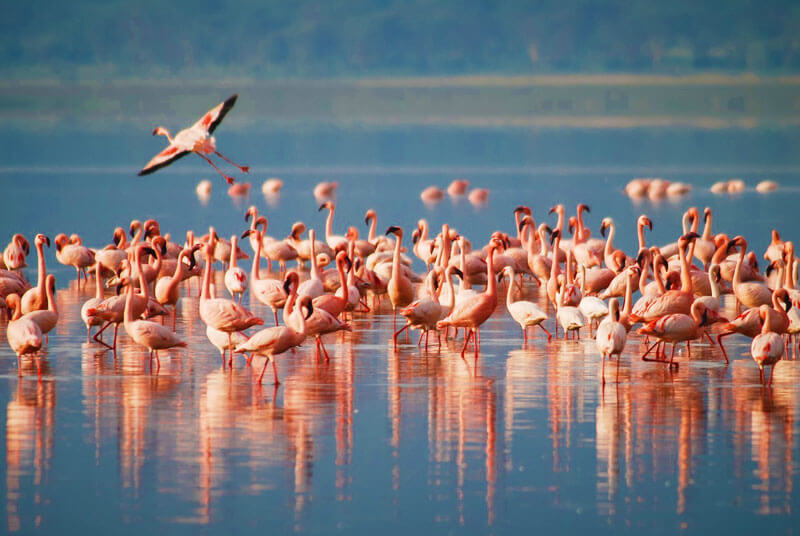
Best Time for a Beach Holiday
Following the general guideline for any trip to East Africa, the best time to visit the Tanzanian island of Zanzibar or the Kenyan coastline is in the dry season from June-October. This is especially true for travellers looking to combine their beach holiday with a safari.
If you’re willing to wait out daily showers, then the wet season (November-May) can be an excellent time to enjoy the perks of quieter beaches and off-season rates.
The start of the year is often a time that is overlooked by many people planning a trip to East Africa’s beaches. A dry spell usually takes place during this time between the end of the short rains and the start of the long rains (January-February).
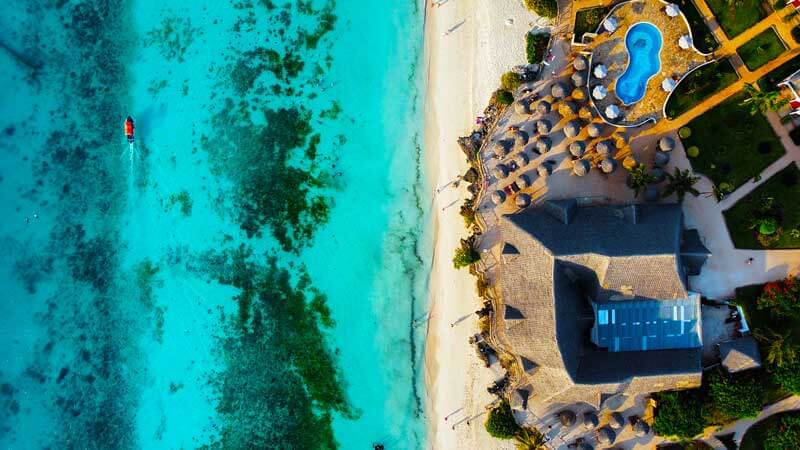
Best Time to Climb Kilimanjaro or Mount Kenya
It is possible to trek Kilimanjaro or Mount Kenya all year round. However, certain months are characterised by colder weather, more rain and potentially loads of snow on the summit.
The dry spell from January-March is one of the best times to take on the challenge. Not only is there a small chance of rain, but temperatures on the summit are generally more favourable. The dry season from June-October also provides ideal trekking conditions.
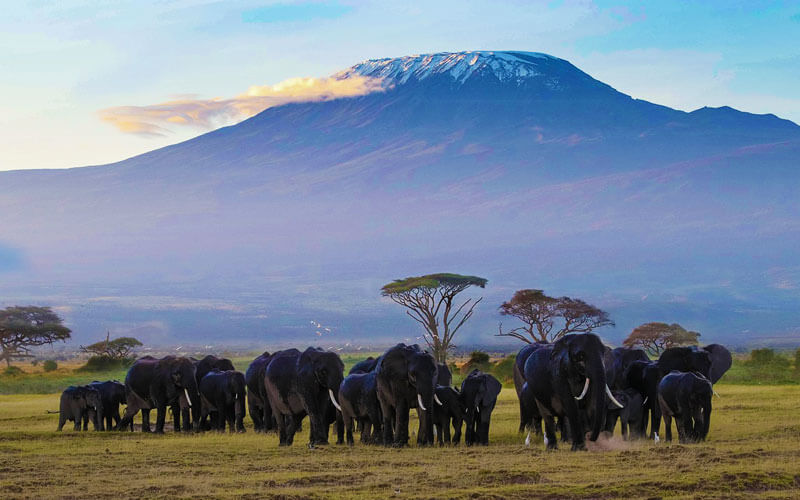
Where to Visit – Kenya or Tanzania?
As two of the world’s most iconic safari destinations, both Kenya and Tanzania are home to an abundance of wildlife. While the countries share similar climates, wildlife species and vegetation; there are notable differences that may help you decide where you want to travel most.
